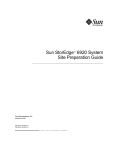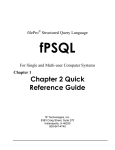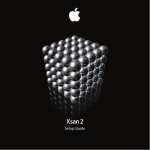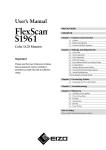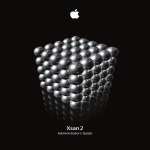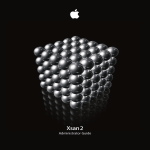Download Apple Xsan Maintenance
Transcript
Xsan Technology Overview June 2005 Technology Overview Xsan Contents Page 3 Introduction Page 4 SAN Basics DAS and NAS Architectures Why a SAN with a SAN File System? Page 7 Product Overview How Xsan Works Key Features Page 9 File System Capabilities Cluster File System High-Availability Features Volume Management Data Access Control Remote Administration Tools Compatibility and Interoperability Page 16 Deploying Xsan Xsan for Post-Production Workflows Xsan in the Data Center Xsan for High-Performance Computing Page 19 Support and Training AppleCare Xsan Support Training and Certification Page 20 Purchasing Information 2 Technology Overview Xsan 3 Introduction Now everyone in your organization can have fast, concurrent access to terabytes of centralized data: introducing Xsan, the SAN file system for Mac OS X. By adding Xsan to its lineup of server and storage products—Xserve G5, Xserve RAID, and Mac OS X Server—Apple now offers a powerful, scalable SAN solution with breakthrough ease of use and affordability. Xsan cuts production costs “ Xsan is the holy grail of storage for Final Cut Pro. We can take advantage of the application in a fully networked environment to edit reality TV in real time at a third of the cost of existing solutions.” —Mark Raudonis Director of Post Production Bunim-Murray Productions Xsan is a 64-bit cluster file system specifically designed for small and large computing environments that demand the highest level of data availability. This specialized technology enables multiple Power Mac and Xserve systems to share RAID storage volumes over a high-speed Fibre Channel network. Each client can read and write directly to the centralized file system, accelerating user productivity while improving workgroup collaboration. Enterprise-class features, such as metadata controller failover, Fibre Channel multipathing, and built-in volume management, make Xsan an ideal choice for storage consolidation and NAS replacement in data centers. Tested support for up to 64 systems—all with read and write access to shared volumes—allows Xsan to accelerate high-bandwidth workflows in film and video. And with groundbreaking prices, Xsan meets the low cost requirements of computational clusters. Whether in data centers, video post-production facilities, or high-performance computing environments, Xsan delivers these important benefits: • Storage consolidation. Pool data across multiple RAID arrays for better performance and more efficient storage utilization. • High throughput. Eliminate the bottlenecks of Ethernet-based networks. • Simultaneous read/write access. Enable workgroups to collaborate easily and accomplish results faster than ever due to concurrent file access. • Easy volume scalability. Plug in more RAID devices as storage requirements grow— expanding the shared volume easily. • Increased data availability. Eliminate single points of failure through metadata controller failover and Fibre Channel multipathing. As you’d expect from Apple, Xsan delivers all of this performance, flexibility, and scalability without the complexity—or the cost—of competitive SAN solutions. And this easy-to-use, affordable SAN file system for Apple computers and servers is available today. 4 Technology Overview Xsan SAN Basics Over the past decade, virtually every industry has experienced exponential growth in storage requirements. Beyond a demand for capacity, organizations are increasingly concerned with data protection, as well as near-instant and reliable access to missioncritical files. Three basic types of storage networking architectures have emerged to address these needs: directed-attached storage (DAS), network-attached storage (NAS), and the storage area network (SAN). To appreciate the benefits of Xsan, it’s helpful to understand the differences among storage architectures and the advantages of a SAN file system. DAS and NAS Architectures Limitations of DAS and NAS systems DAS and NAS architectures suffer from the same limitations, including: • Single point of failure. The DAS host or NAS appliance is the single point of access to storage—and, potentially, a single point of failure. • Performance bottlenecks. Since all file system requests must go through a single workstation or server, performance bottlenecks occur. These bottlenecks can be magnified by Ethernet bandwidth limitations. • Difficult scalability. In both scenarios, scalability is limited by the number of storage devices that can be attached to the server. It’s also cumbersome to add disks or RAID arrays to NAS or DAS systems. Direct-attached storage (DAS) In a DAS configuration, disk drives or storage systems are connected directly to a server over SCSI or Fibre Channel. The host server formats the DAS using a compatible disk file system, such as UFS or HFS+, and shares the storage with clients over Ethernet using a network file system, such as AFP, SMB/CIFS, or NFS. Direct-Attached Storage External storage Fibre Channel or SCSI interconnect File server Performance bottleneck and potential single point of failure. Ethernet LAN Client systems Technology Overview Xsan 5 Network-attached storage (NAS) A NAS is a storage device with a built-in computer. This “NAS appliance” connects to a local area network and, like a DAS, shares storage with clients over Ethernet using a network file system. A NAS appliance typically features a specialized server operating system designed to make file-sharing setup and maintenance easier than with most general-purpose servers. Network-Attached Storage NAS appliance Embedded file server File server Same performance and scalability limitations as direct-attached storage. Ethernet LAN Client systems Why a SAN with a SAN File System? • • • • • Benefits of consolidated storage A SAN file system provides important benefits over DAS and NAS architectures: Fast, concurrent file sharing for streamlined workflows Increased uptime through the elimination of single points of failure Simplified administration and access controls using directory-based management Reduced costs through more efficient disk use Flexible deployment and easy scalability without interrupting operations A storage area network, or SAN, is a method of aggregating storage devices and allowing servers and client computers to access them as a single virtual storage entity. The volume looks just like a DAS—like a big hard drive—to the servers. The difference is that, with a SAN file system such as Xsan, all the servers can access the storage volume at the same time. These host servers can then share the data with additional clients on the local Ethernet network using a network file system, such as AFP, SMB/CIFS, or NFS. Storage Area Network SAN Multiple storage devices Fibre Channel switch File server File server File server Multiple servers access a network of storage devices. Ethernet LAN Client systems Technology Overview Xsan 6 High-performance, concurrent file sharing Unlike NAS or DAS systems, which use network file-sharing protocols to deliver stored data to clients, a SAN typically uses a high-speed Fibre Channel interconnect. SCSI data and commands are sent across the SAN over high-speed Fibre Channel protocols for faster file access and more efficient sharing. This allows many users in a workflow to work with the same data at the same time, facilitating collaboration and increasing productivity. Network-based storage management By consolidating data into one shared volume, you can utilize all available storage resources more efficiently—and with greater flexibility. Storage devices can be connected using a Fibre Channel switch to any computer or server on the SAN. Centralized storage also streamlines management and makes it easier to control user access. Why a SAN file system? Storage devices on the SAN appear as Logical Unit Numbers, or LUNs. A LUN may be a disk, a RAID set, or a slice of a RAID set. Using a SAN file system, a SAN can aggregate LUNs into a single volume, permitting simultaneous access to the same data from multiple systems, while maximizing resource utilization and scalability. A SAN by itself—without a SAN file system— must assign, or “provision,” each LUN to an individual server or computer for its exclusive use. This effectively separates data into “silos,” stopping short of the collaboration benefits of a SAN, as well as many of the management and scalability benefits. Eliminating single points of failure Because a SAN file system gives multiple servers access to shared storage, you can eliminate single points of failure. For example, if one of the servers fails, another server can take over its job and continue to serve the data to clients on the network. Flexible SAN topology With a SAN file system, such as Xsan, it’s easy to expand the capacity of your SAN as storage needs grow. Simply add more Xserve RAID systems, and you can expand existing volumes—or create new ones—that can be shared among the attached servers. To increase the available bandwidth or processing power to your network services, you can add more servers running the Xsan file system. These new systems can have immediate block-level access to the same storage volumes and host network services, such as web serving, file sharing, or media streaming, to additional network or Internet clients. SAN File System Scalability SAN volume Volume scales dynamically as you add storage devices. Performance scales as you add servers. Ethernet LAN Client systems Technology Overview Xsan 7 Product Overview How Xsan Works Xsan teams with best-in-class Apple products—Xserve RAID, Xserve G5, Power Mac G5, Mac OS X, and Mac OS X Server—to provide an affordable, end-to-end SAN solution for demanding storage environments. Here’s how the Xsan solution works. Xsan Storage Area Network SAN volume Metadata controller Fibre Channel switch Servers Ethernet LAN Client systems SAN volume. Xsan allows you to consolidate data into a single storage volume that’s accessible to all systems on the SAN. Adding capacity is as easy as attaching more Xserve RAID systems to your Fibre Channel network. Xsan clients. Computers and servers running Xsan have direct block-level access to files stored on the SAN volume and full read/write capability. As performance needs grow, Xsan allows you to add servers and computers to the SAN. Fibre Channel network. The SAN volume connects to the Xsan metadata controller and all Xsan clients through a highspeed Fibre Channel switch. Apple has qualified many popular third-party switches for use with Xserve RAID and Xsan. Ethernet network. File system metadata is handled “out of band” over a private Ethernet network shared by all systems connected directly to the SAN. This frees up Fibre Channel bandwidth for high-performance storage throughput. Xsan metadata controller. Xsan includes software called the “metadata controller,” which acts as the traffic cop for the SAN. When an Xsan client attempts to read or write to a file, it gets permission from the metadata controller, then accesses the data directly on the SAN over high-speed Fibre Channel. Any Power Mac or Xserve running Xsan can be the metadata controller. Network clients. An Xserve with Mac OS X Server and Xsan can share data from the SAN volume with an unlimited number of networked computers using network file-sharing protocols, such as AFP, SMB/CIFS, and NFS. Technology Overview Xsan 8 Key Features Xsan is a specialized file system that enables you to manage terabytes of consolidated storage and provide high-availability, high-performance data access across your network. Its features include the following. • • • • • Components of an Xsan solution Xsan extends the value of these highperformance Apple products: Mac OS X Server is Apple’s easy-to-manage, UNIX-based server operating system, which has more than 100 popular open source projects built in. Xserve G5 packs 64-bit PowerPC G5 processing power and up to 1.2TB of storage into a 1U rackmount enclosure.1 An unlimited-client license for Mac OS X Server is included at no additional cost. Xserve RAID features hot-swappable Ultra ATA drives for up to 5.6TB of storage,2 as well as fast dual 2Gb Fibre Channel connectivity. This powerful RAID system is not only easy to use, but easy to afford—just over $2 per gigabyte.3 The Power Mac G5 is the ultimate video workstation. A high-bandwidth architecture ensures that data flows through the biggest available pipe. The Apple Fibre Channel PCI-X Card enables Xserve G5 and Power Mac G5 systems to access Xserve RAID storage using a dual-port 2Gb Fibre Channel interface. 64-bit cluster file system Xsan supports volume sizes of up to 2 petabytes (PB) and billions of files per volume.1 Features such as file-level locking and block-level access allow high-speed, concurrent read/write access to storage volumes from multiple systems. Multiple users can access even very large files simultaneously—improving efficiency of post-production and other data-intensive workflows, because everyone can be working with the same files on the network. Xsan also reduces transfer time, thanks to the high-performance Fibre Channel connection. High availability Xsan has a high-availability design that allows users to access mission-critical data even in the event of a system or Fibre Channel network failure. Metadata controller failover protects storage availability from server hardware failure. File system journaling tracks modifications to metadata, enabling quick recovery of the file system in case of unexpected interruptions in service. And Fibre Channel multipathing allows file system clients to automatically use an alternate data path in the event of a failure. Volume management Volume management and easy file system scalability maximize the flexibility of your storage deployments. Xsan allows you to create storage pools made of identical sets of LUNs and stripe them together for fastest-possible performance. Different pools offering special storage characteristics can be combined into volumes; and data placement settings, or affinities, enable you to direct data to specific volumes depending on performance and protection requirements. Data access control Xsan simplifies administration with flexible data management features. Using volume mapping, you can control which SAN volumes are visible to specific nodes in the SAN. Integration with Open Directory, Active Directory, or any other enterprise LDAP directory service allows centralized management of user and group access privileges. Directory-based management also makes it easy to set file system quotas, so you can control resource utilization on a per-user, per-group, or per-application basis. Remote administration tools Built-in Xsan administration software provides volume management, SAN file system configuration, and remote monitoring in one integrated application. These easy-to-use administration tools can even send you automatic event notifications via email or pager. Compatibility and interoperability Built to work with existing infrastructures, Xsan is compatible with native Mac OS X applications and many leading Fibre Channel switches, including those from QLogic, Cisco, Emulex, and Brocade. Xsan also interoperates with StorNext File System from ADIC, allowing you to share storage volumes with Windows, Linux, and UNIX systems. Technology Overview Xsan 9 File System Capabilities Xsan features enterprise-class SAN capabilities that meet your organization’s requirements for data consolidation and fast, shared access to storage volumes. Take a closer look at these powerful features. Cluster File System Xsan is a 64-bit cluster file system that provides concurrent data access over highspeed Fibre Channel to multiple systems on the network. For better performance and higher availability, you can pool storage across multiple RAID devices, and each Xsan client can use this centralized data as if it were directly connected. Cluster file systems of this class include SGI InfiniteStorage Filesystem CXFS and VERITAS Storage Foundation Cluster File System. Support for 2PB files and volumes Xsan on Mac OS X v10.4 “Tiger” lets your users share multiple files and volumes; each can be as large as 2PB, or more than 3 months’ worth of uncompressed 1080i high definition (HD) video at 30 frames per second. Xsan supports billions of files per volume, with each metadata controller hosting multiple volumes at the same time. File sharing over Fibre Channel Xsan storage networking eliminates the bottlenecks of traditional network file servers that use Gigabit Ethernet and that are not fast enough to transfer dense formats such as HD video. Fibre Channel gives you a 2Gb-per-port connection for increased data transfer and can be used with Fibre Channel multipathing for greater aggregate throughput. This is perfect for multiple editors working on a video project or a compute cluster that needs fast data access for maximum utilization of processing power. File-level locking Fine-grained file-level locking enables simultaneous access to shared files. All clients can access all the files on the volume, but only the client that has read/write privileges can edit a locked file. This contrasts with volume-level locking, which enables only one computer at a time to write to an entire volume. File-level locking provides enormous productivity advantages in post-production workflows where multiple editors are using a single large file. Bandwidth reservation Xsan includes easy-to-use APIs that enable developers and administrators to prioritize throughput for one system on the SAN or for a mission-critical application. This is ideal for bandwidth-intensive operations, such as capturing, or ingesting, uncompressed HD video. Technology Overview Xsan 10 High-Availability Features Xsan is designed for high availability, with features that make it well suited for missioncritical environments. Metadata controller failover and Fibre Channel multipathing eliminate single points of failure, and bandwidth reservation allows you to keep bandwidth available for critical applications. Always Available SAN volume Standby metadata controller Automatic failover to redundant metadata controller. Fibre Channel switch Metadata controller Multipathing ensures data availability—even if one Fibre Channel path goes down. Metadata controller failover If the metadata controller on your SAN fails for any reason, another computer running Xsan can take over. Metadata controller failover is built into Xsan, unlike many SAN solutions that require you to pay extra for this high-availability feature. Xsan software includes both the metadata controller and file system client components. Using Xsan administration tools, you can specify the “laws of succession,” or the order in which Xsan metadata controllers take over for a failed controller. Sophisticated algorithms ensure that succession occurs properly, avoiding “split brain,” or multiple conflicting metadata controllers. Once the file system clients “elect” a new metadata controller, the failed system can be deactivated until the problem is resolved. For high-volume, mission-critical production environments, you may want to dedicate a computer as a standby controller. A standby controller also enables you to update Xsan software without interrupting service to your users. Fibre Channel multipathing Apple’s Fibre Channel host bus adapters (HBAs) are dual-port cards, providing every Power Mac or Xserve system with two connections to the SAN. Fibre Channel multipathing takes advantage of this dual connection: If one Fibre Channel path fails, Xsan continues to use the other for storage access—eliminating a potential single point of failure at the cabling layer. All data paths from the client to the various storage volumes are discovered automatically based on load and availability. This provides two major benefits: Any failure is handled without affecting the user’s work, and all paths are load-balanced to ensure maximum performance and reliability. Technology Overview Xsan 11 File system journaling Xsan is a journaled file system that can be recovered in seconds in the event of a server failure. Journal data includes a record of file system transactions, eliminating the need for time-consuming integrity checks after an unplanned shutdown of the entire network or of the metadata controller. Your storage can be back online immediately. Volume Management Flexible volume management capabilities enable you to maximize the efficiency of your storage resources. Xsan makes it easy to target data types to specific classes of storage for optimal storage performance—for example, assigning all uncompressed HD video files to one high-performance storage pool. You can then combine pools into volumes for simplified management. Xsan also makes it easy to expand your storage resources as your data needs grow: You can add LUNs and storage pools and create new volumes—without interruption in service. The downtime to grow a volume is typically just seconds. Storage pools and SAN volumes Storage pools allow you to aggregate storage resources with similar attributes. Using Xsan administration tools, you can pool LUNs with identical size, performance, and data protection properties. Different types of storage pools can then be combined into the same volume. For example, you can create one storage pool of RAID 5 LUNs and another pool of RAID 1 LUNs. The RAID 5 LUNs provide high performance and good capacity with some protection. The RAID 1 sets use redundant drives for the highest level of protection. By creating a SAN volume from these two different pools, you can achieve a good balance between speed and protection in a single volume. This allows the administrator to choose how to manage storage, without having to involve the user. A storage pool can contain up to 32 LUNs and a volume can contain up to 512 LUNs. Volume Management Build RAID set in RAID Admin. Xserve RAID LUN Build Xsan volume in Xsan Admin. Storage pool 1 1 Storage pool Volume Multiple LUNs Technology Overview Xsan Stripe 1 Stripe 2 Stripe 3 Stripe 4 Stripe 5 Stripe 6 Stripe 7 Stripe 8 Stripe 9 Stripe 10 Stripe 11 Stripe 12 ... ... ... Volume 1 Volume 2 Volume 3 Striping at a higher level Xsan stripes data across the individual LUNs that make up a storage pool. This improves performance because multiple pieces of the file are written in parallel, instead of one piece at a time. You can tune Xsan performance by adjusting the amount of data written to each LUN in a storage pool. 12 Affinities for automated data placement Affinities allow you to allocate different classes of storage to different purposes, without forcing users to adhere to annoying rules. Using Xsan administration tools, you can set up an affinity between a folder and a specific storage pool, so that files in the folder are stored only on that pool. Seamless to the end user, affinities ensure that an application or task that requires speed or extra protection always stores its files in a suitably fast or protected pool. In this example, users have two folders in the volume: One is named “Fastest,” associated with the pool of RAID 5 sets; the other is named “Most Protected,” associated with the pool of RAID 1 sets. During development, working files can be maintained in the Fastest folder, which automatically places them in a RAID 5 pool. Finished work is saved to the Most Protected folder and maintained in a RAID 1, or mirrored, pool. SAN Volumes SAN volume Fastest Most Protected RAID 5 storage pool RAID 1 storage pool Data Access Control Xsan works with your directory server to help you manage file ownership and access quotas—protecting your organization’s data and improving storage utilization. With LDAP integration, a central directory allows you to create consistent file system permissions across all computers accessing the storage. Volume mapping Using Xsan administration tools, you can map storage volumes to specific systems on the SAN, enabling you to define which systems can see which volumes. This protects your organization’s sensitive information without getting in the way of authorized use. Although all Mac OS X file permissions still apply to Xsan, volume mapping provides an added layer of control and security. LDAP integration Because Xsan is simply another file system, it adheres to the file system permissions built into Mac OS X, including permissions established in a central LDAP directory. Whether you use Open Directory, Active Directory, or another enterprise LDAP service, Xsan accesses information in the directory accounts that you have in place—making it easy to share permissions across computers. Technology Overview Xsan 13 You can use Xsan administration tools to set user and group permissions, as well as access privileges, at several levels: • Restrict user access to folders on a volume by specifying owner, group, and general access permissions. • Unmount a SAN volume from selected client computers. • Restrict a client computer to read-only access to a volume. • Remove a client from a SAN. Disk quotas LDAP integration also makes it easy to manage disk space quotas. You can assign quotas to users, groups, applications, or any combination of the three. Xsan enforces two types of quotas for each user, group, or application: • Soft quota. The soft quota is the maximum space a user or group is expected to occupy on a regular basis. Users can exceed their soft quota, for a specified grace period only, up to their hard quota. • Hard quota. The hard quota is an absolute limit on the space a user or group can occupy. Users are prevented from using more space than specified by their hard quota. Users or groups can exceed their soft quota provided that they drop below it at some point during the grace period you specify. If users or groups exceed their soft quota for longer than the grace period, the soft quota changes to a hard quota; they will not be able to save additional data on the volume until they delete old files and drop below the soft quota. Quotas are set individually for each volume in a SAN. To establish clear limits, you can set the soft quota, hard quota, and grace period in combination—while still allowing temporary access to extra space for unexpected storage needs. Users for whom no quotas are specified can use all available space on a volume. Technology Overview Xsan 14 Remote Administration Tools Xsan includes Xsan Admin, a set of tools for managing and monitoring your SAN. An intuitive graphical user interface enables you to perform complex administration tasks—such as creating storage pools, managing SAN volumes, setting up affinities, and assigning quotas—that would otherwise be accessible only from a command-line interface. Command-line tools are also included for UNIX-savvy administrators. Xsan Admin is easy to install and configure on Mac OS X and Mac OS X Server systems. Installation and configuration can be performed locally or remotely over your LAN. Real-time monitoring Xsan Admin features real-time monitoring of Xsan SANs, providing the following information: • • • • • • • • Free space in a volume or storage pool User quota utilization Graphs of processor and network utilization Status of file system processes Log file Connected clients Fibre Channel failures Status of Xserve RAID systems Event notification You can also use Xsan Admin to set status thresholds that trigger automatic notification via email or pager. Whether a critical workstation is nearing its disk quota or your metadata controller shuts down suddenly, the notification feature enables you to respond to serious problems quickly. Technology Overview Xsan 15 Compatibility and Interoperability Xsan lets you create a SAN that is compatible with your existing infrastructure—giving you the flexibility to build a system that’s right for your organization, while maximizing the return on your storage investment. Support for native Mac OS X applications Xsan is designed to support most native Mac OS X and UNIX applications and delivers incredible performance on Power Mac and Xserve systems. For maximum flexibility and compatibility with non-Apple systems, it uses a case-sensitive, single-fork file system. Fibre Channel infrastructure integration Apple has qualified several of the most popular Fibre Channel switches for use with Xsan, Xserve RAID, and the Apple Fibre Channel PCI-X Card. These include the QLogic SANbox2-8, SANbox2-16, SANbox2-64, and SANbox 5200; the Cisco MDS 9000 family; the Emulex SAN Storage Switch 355, Emulex SAN Storage Switch 375, and Emulex 9200; and the Brocade SilkWorm 3200, SilkWorm 3800, SilkWorm 3900, and SilkWorm 12000 series. Sharing data over Ethernet With an Xserve on your Xsan network, you can easily share storage using a network file system protocol, such as AFP, SMB/CIFS, or NFS—all built into Mac OS X Server and included at no additional cost with every Xserve system. ADIC integration In heterogeneous computing environments, you can add non–Mac OS X clients to your Xsan network using ADIC’s StorNext File System. Computers running StorNext File System on Windows XP, Windows 2003, Windows NT, Windows 2000, Linux, IRIX, Solaris, and AIX can access Xsan volumes directly over high-speed Fibre Channel—without any modification. In addition, Mac and Xserve clients with Xsan can be added to an existing ADIC-based SAN environment. Mixed-Platform SAN Xsan volume Metadata controller Fibre Channel switch File system client File system client File system client ADIC has also announced that its StorNext Management Suite will support Xsan. This policy-based information lifecycle management (ILM) solution can be used in conjunction with ADIC’s Scalar line of tape libraries, offering a robust tape backup option for your Xsan volumes. Technology Overview Xsan 16 Deploying Xsan Xsan relies on a proven architecture that’s ideal for video post-production workflows, data centers, and high-performance computing environments. What’s more, the Apple solution is available at a fraction of the cost of competitive solutions. Xsan for Post-Production Workflows High-bandwidth RAID architecture With a video-optimized architecture and dual independent 2-Gbps Fibre Channel interfaces, Xserve RAID provides the fast, consistent performance required for video post-production. It delivers up to 380-MBps sustained throughput—enough for working in HD video or supporting multiple streams of uncompressed SD video with real-time effects. Bandwidth requirements A SAN allows editors to work well within the bandwidth required per video stream for various common editing formats. • Standard definition: – 3.6 MBps for MiniDV, DVCAM, and DVCPRO – 7.7 MBps for DVCPRO 50 – 20 MBps for uncompressed 8-bit – 27 MBps for uncompressed 10-bit • Compressed high definition: – 5.8–14 MBps for DVCPRO HD • Uncompressed high definition: – 46 MBps for 720p 24 fps – 50 MBps for 720p 30 fps – 100 MBps for 720p 60 fps – 98 MBps for 1080 24p (8-bit) – 120 MBps for 1080i (8-bit) – 110 MBps for 1080 24p (10-bit) – 165 MBps for 1080i (10-bit) Professionals in film, broadcast, and video post-production depend on high-bandwidth, scalable storage that can be accessed concurrently by multiple workstations. The SAN—not the LAN—becomes the key to collaboration and efficient workflow for these organizations. A SAN simplifies the work for end users, eliminates data duplication between systems, and reduces overall storage needs. Apple’s SAN solution using Xsan with Xserve RAID delivers these benefits in film and video editing environments: • Concurrent access to source files. Multiple editors can work from the same source media concurrently, without ever having to transfer these files between stations. Each Mac accesses shared files on the SAN as though the storage were directly attached. File-level locking ensures that only one station at a time can modify the contents of the file. • Consistent high-bandwidth performance. Xsan is designed for demanding applications where guaranteed rate of bandwidth must be maintained, such as ingesting video or audio data from tape to a digital storage system without frame drops. Using Fibre Channel technology, Xsan delivers consistent high-bandwidth performance. For finer-grained control, included Xsan APIs enable critical applications to reserve bandwidth for file system operations. Post-Production SAN SAN volume Metadata controller Fibre Channel switch Stream media and share files over the network using Mac OS X Server. Technology Overview Xsan 17 • Storage consolidation. A consolidated storage repository eliminates the need for high-speed DAS devices attached to individual workstations. Consolidation also increases total available storage and reduces hardware costs, while facilitating project management, access control, and storage security. • Tremendous capacity. With Xsan and Xserve RAID, you can work with files and volumes of up to 2PB,1 making it easy to share enormous media files. Each Xserve RAID system can hold up to 5.6TB of data.2 • Dynamic scalability. A SAN architecture is easy to scale with minimal interruption in service. Simply plug more Xserve RAID systems into the Fibre Channel network for more capacity and better storage performance. To expand the number of editing stations, simply install Xsan on the additional stations and attach them to the SAN. Xsan in the Data Center IT departments in every industry are facing constant growth in data storage needs, as well as more stringent government regulations for maintaining compliant records. Together these requirements place tremendous demands on storage infrastructures. By consolidating storage, reducing data duplication, centralizing management, and increasing the flexibility of existing storage hardware, a SAN solution can reduce an organization’s storage needs and lower its IT costs. Powerful and affordable IT solutions Xsan lets you deploy centralized SAN solutions that take advantage of the performance, availability, and low price per gigabyte of Apple’s Xserve RAID storage system. To provide scalable file services for Mac, Windows, and Linux clients on the network, you can use Xserve as a “NAS head”—a server attached to a SAN with NAS functionality. An Xsan network can increase the flexibility of your storage infrastructure and the utilization of your storage resources, thanks to these features: • Consolidated storage resources. An Xsan solution allows IT administrators to consolidate data and manage it centrally—increasing storage utilization and simplifying data management without compromising performance and scalability. You can allocate storage to any application, anywhere in the organization, thanks to built-in volume management and mapping tools. What’s more, consolidation results in dramatically simpler scalability: Just add more Xserve RAID systems for expanded SAN capacity and increased performance. • Simultaneous data delivery. An Xsan network is ideal for delivering load-balanced database services, home directory services, mail services, or web services. All your servers can share a single large storage repository, eliminating the need to duplicate data or divide data among multiple servers. Even your failover server doesn’t need its own duplicate copy of the data: It can use the same files as the primary server. • Increased uptime. Because one server is no longer the single point of access for stored data, you can increase the throughput and the reliability of your network services. An Xsan network makes it easy to take one system offline for updates—or add systems to meet expanding needs—without interrupting operations. In addition, Xsan offers high-availability features such as metadata controller failover and Fibre Channel multipathing. • Cross-platform integration. Because Xsan is compatible with ADIC’s StorNext File System, you can provide Windows, Linux, and other UNIX systems with direct Fibre Channel block-level access to your Xsan volumes. Power Mac and Xserve systems running Xsan can also join existing infrastructures that use ADIC’s StorNext Management Suite, a policy-based information lifecycle management (ILM) solution. When ADIC’s StorNext Management Suite is deployed in conjunction with its Scalar line of tape libraries, you can set up predefined service levels for different classes of data and automate your data placement and storage backup policies. Technology Overview Xsan 18 Xsan for High-Performance Computing Xserve G5 cluster node Using affordable Xserve G5 cluster nodes, scientists and engineers have built powerful computational clusters, including some of the fastest supercomputers in the world. Recent gains in processing power have enabled scientists and researchers to build world-class computational clusters using inexpensive servers, such as Apple’s Xserve G5 running Mac OS X Server, for a fraction of the cost of comparable supercomputer solutions. Also known as high-performance computing, these techniques are used for scientific analysis, in render farms, and for other specialized, processor-intensive applications. A computational cluster runs an application against a single large data set. Typically data sets are moved into the cluster and results are gathered from the cluster using common network file system techniques. This can lead to data management challenges, as it’s imperative that each computer uses the correct data set. In addition, in the case of very large data sets or very large clusters, the network file server can become a bottleneck. As in data center environments, Xsan can remove these limitations, providing dramatically faster and more scalable data sharing across small and large clusters. Deploying small clusters over Fibre Channel With a small cluster, comprising fewer than 60 nodes, every node can share access to an Xsan volume using a high-speed Fibre Channel network. Each node can read from the same data set and each node can return its results to the same folder in the file system, eliminating data replication and simplifying data management. Sharing data over a SAN also provides significant performance improvements over traditional file servers. Multiple systems have simultaneous access to exactly the same data. Data is never transferred over the LAN, preventing Ethernet bottlenecks and avoiding idle computing cycles while nodes wait for data to process. Deploying larger clusters with Fibre Channel and Ethernet With a larger cluster comprising hundreds of nodes, the configuration shifts to a hierarchical structure. Head nodes are used to manage a group of cluster nodes. For example, a 200-node cluster may have 10 head nodes each managing 20 client nodes. The head nodes, all running Xsan, connect directly to the SAN using a Fibre Channel network and share the SAN volume with their client nodes using a network file system protocol, such as NFS over Gigabit Ethernet. Because the file sharing on each network segment is limited to 20 nodes, network performance across the cluster is improved and data management is simplified. This method for accessing and distributing data is faster and uses less network bandwidth across the cluster than do typical NAS solutions. At the end of the run, nodes return the processed data to the head nodes, which in turn write directly to the shared SAN volume. Large Computational Cluster SAN volume Metadata controller Fibre Channel switch Head nodes Ethernet Cluster nodes Technology Overview Xsan 19 Support and Training Xsan comes with 90 days of toll-free telephone support for installation, launch, and basic troubleshooting, as well as lifetime access to Apple’s online support resources, such as the AppleCare Knowledge Base and discussion forums. In addition, to keep critical data available day and night, you can purchase the AppleCare Xsan Support plan for round-the-clock support. AppleCare Xsan Support AppleCare Xsan Support delivers a year of priority phone and email support4 for your storage deployment. You’ll have direct access—24 hours a day, 7 days a week—to Apple’s dedicated Xsan Support team. These experts provide in-depth problemsolving assistance with Xsan and RAID Admin software, including support for migration to Xsan upgrades purchased during the support period. They also troubleshoot Apple hardware5 running Xsan, as well as interconnectivity between Power Mac, Xserve, and Xserve RAID systems, including Apple-qualified Fibre Channel switches.6 A separate AppleCare Xsan Support agreement must be purchased for each copy of Xsan software in your network. Because Apple hardware and software are uniquely integrated, there’s just one place to go for help. Apple offers convenient, cost-effective service and support products: the AppleCare Protection Plan for Mac computers and the AppleCare Premium Service and Support Plan for Xserve and Xserve RAID systems. When you combine AppleCare Xsan Support with these AppleCare products, experts can help you troubleshoot your entire Apple storage solution—and even set up a repair—with a single call. To keep video workflows running smoothly, video professionals can purchase AppleCare Professional Video Support to cover Apple video production solutions. And for IT department–level support, network administrators can choose from three levels of Mac OS X Server Software Support. For more information, visit www.apple.com/support/products. Training and Certification Apple offers a comprehensive lineup of instructor-led courses, as well as related certification programs. From application basics to advanced network management, these high-quality courses combine lectures, demonstrations, and hands-on exercises. Classes are taught by Apple Certified Trainers—either at an Apple Authorized Training Center or, by special arrangement, onsite at your business or institution. For more information, visit www.apple.com/training. Technology Overview Xsan 20 Purchasing Information Pricing Apple Maintenance Program This optional program makes it easy to manage software expenditures while benefiting from the latest technologies and improvements. With one payment, you automatically receive major Xsan software upgrades for three years. For more information, including program terms and conditions, visit www.apple.com/server/maintenance. The U.S. suggested retail price of Xsan is $999. The education price is $499.3 One copy of Xsan must be purchased for every Power Mac or Xserve system connected directly to the SAN, including the metadata controller and each client or node. Volume licensing for 10 or more clients is available. There are no fees related to the capacity or number of storage devices in the SAN. Xsan is available worldwide in English, French, German, and Japanese. It can be purchased from the Apple Store at www.apple.com/store, as well as through Apple value-added resellers and select catalogs. System Requirements • Xserve or Xserve G5; or Power Mac G4 (dual 800MHz or faster) or Power Mac G5 (second Ethernet connection recommended) • Apple Fibre Channel PCI or PCI-X Card • 512MB of RAM for metadata controller; 256MB of RAM for client • Mac OS X or Mac OS X Server v10.3.9 or v10.4 Storage Network Requirements • Switched Ethernet LAN • Xserve RAID • Qualified Fibre Channel switches and cables (see www.apple.com/xserve/raid/certifications.html) For More Information For more information about Xsan, visit www.apple.com/xsan. For information about other Apple server and storage solutions, visit www.apple.com/server. 1For hard drive capacity measurements, 1GB = 1 billion bytes, 1TB = 1 trillion bytes, and 1PB = 1000 terabytes; actual formatted capacity less. 2Maximum capacity of 5.6TB achieved through use of fourteen 400GB Apple Drive Modules. Usable capacity depends on drive configuration and RAID level. 3Price in U.S. dollars, valid in U.S. only; prices subject to change. 4Telephone numbers and hours of operation may vary and are subject to change; local telephone fees may apply. Access to web-based resources requires the use of a compatible Internet service provider; fees may apply. 5Software support covers only the graphical user interface. Hardware repairs that are not covered under warranty require an extended service contract, such as the AppleCare Protection Plan. 6For a list of Apple-qualified Fibre Channel switches, see www.apple.com/xsan/compatibility.html. © 2005 Apple Computer, Inc. All rights reserved. Apple, the Apple logo, Mac, the Mac logo, Mac OS, Power Mac, the QuickTime logo, and Xserve are trademarks of Apple Computer, Inc., registered in the U.S. and other countries. Xsan is a trademark of Apple Computer, Inc. AppleCare and Apple Store are service marks of Apple Computer, Inc., registered in the U.S. and other countries. Other company and product names mentioned herein may be trademarks of their respective companies. Product specifications are subject to change without notice. This material is provided for informational purposes only; Apple assumes no liability related to its use. June 2005 L310300A




















